Assessment 1: Business Structures - Sole Trader vs Partnership
VerifiedAdded on 2021/04/21
|13
|3057
|246
Report
AI Summary
This report, prepared for an assessment, examines business structures in Australia, focusing on sole trader and partnership models. It begins with a discussion with a potential business owner, Julie, exploring her aspirations and concerns about starting a pottery business. The report then delves into the legal and operational aspects of sole trader businesses, highlighting their simplicity, control, and minimal regulatory requirements. It also addresses the concept of unlimited liability and tax implications. The second part compares sole trader and partnership structures, evaluating the advantages and disadvantages of each concerning control, liability, and fundraising capabilities. The report concludes that the sole trader structure is the most suitable for Julie's business needs, given her desire for autonomy and the scale of her intended operations, while also acknowledging the existence of partnership as a viable alternative.
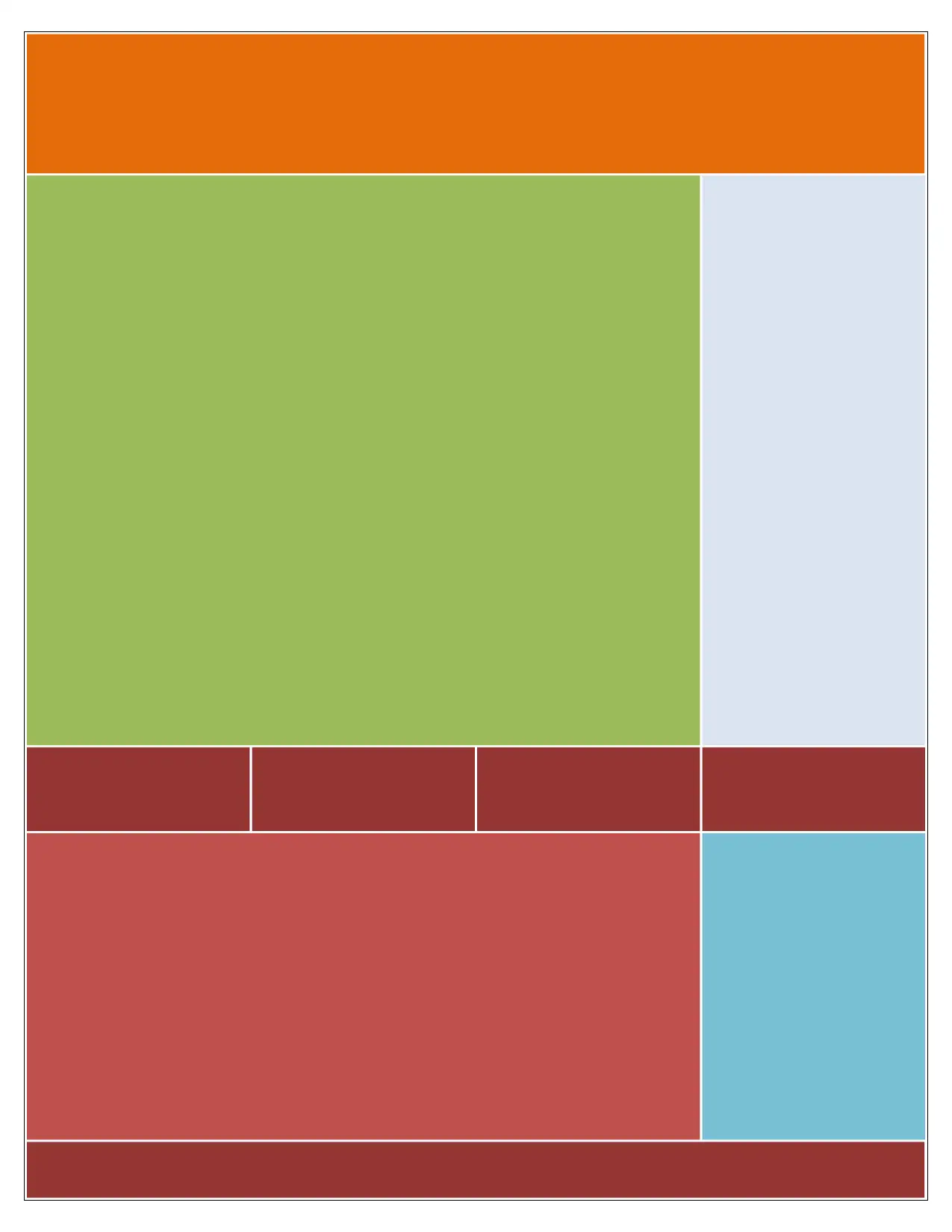
Paraphrase This Document
Need a fresh take? Get an instant paraphrase of this document with our AI Paraphraser
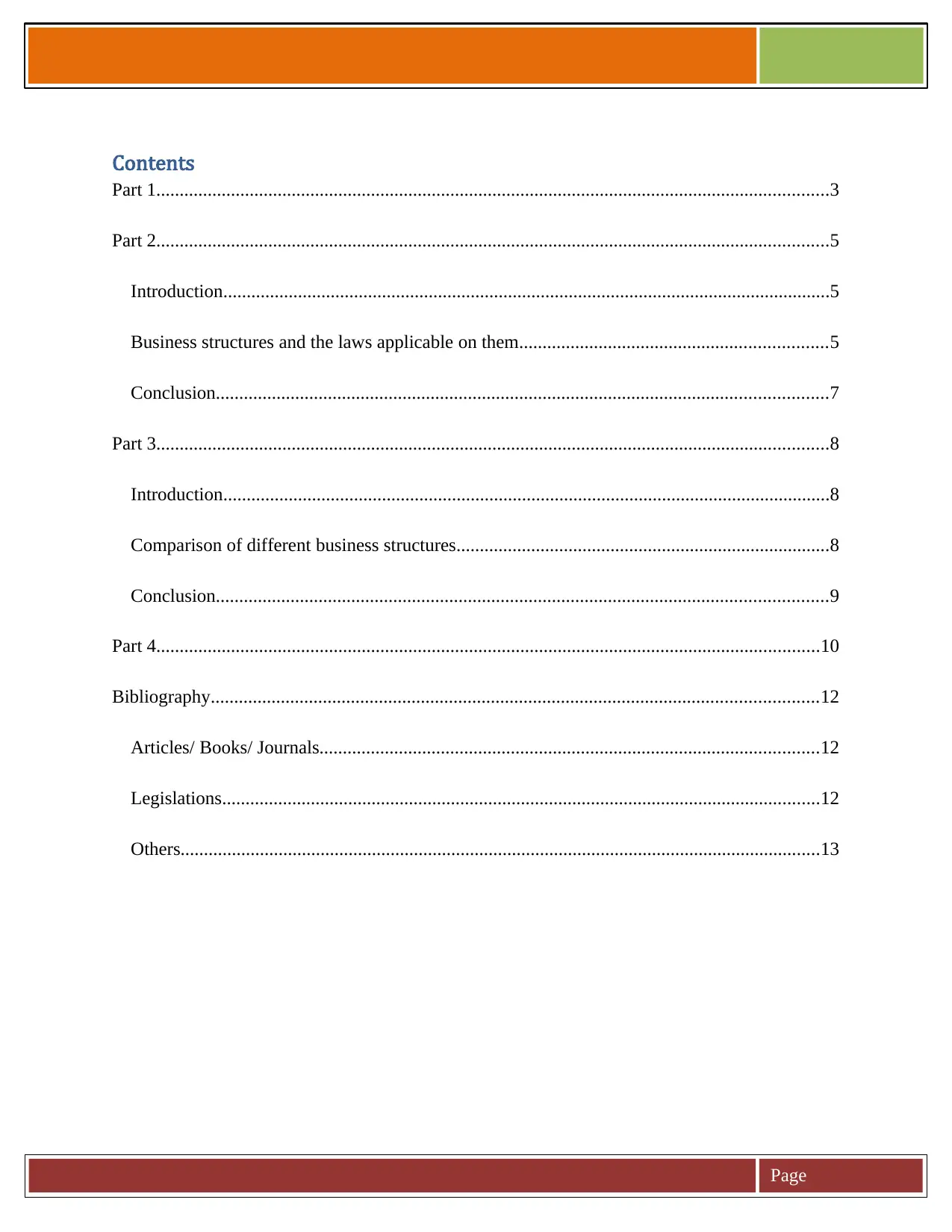
Page
Contents
Part 1................................................................................................................................................3
Part 2................................................................................................................................................5
Introduction..................................................................................................................................5
Business structures and the laws applicable on them..................................................................5
Conclusion...................................................................................................................................7
Part 3................................................................................................................................................8
Introduction..................................................................................................................................8
Comparison of different business structures................................................................................8
Conclusion...................................................................................................................................9
Part 4..............................................................................................................................................10
Bibliography..................................................................................................................................12
Articles/ Books/ Journals...........................................................................................................12
Legislations................................................................................................................................12
Others.........................................................................................................................................13
Contents
Part 1................................................................................................................................................3
Part 2................................................................................................................................................5
Introduction..................................................................................................................................5
Business structures and the laws applicable on them..................................................................5
Conclusion...................................................................................................................................7
Part 3................................................................................................................................................8
Introduction..................................................................................................................................8
Comparison of different business structures................................................................................8
Conclusion...................................................................................................................................9
Part 4..............................................................................................................................................10
Bibliography..................................................................................................................................12
Articles/ Books/ Journals...........................................................................................................12
Legislations................................................................................................................................12
Others.........................................................................................................................................13
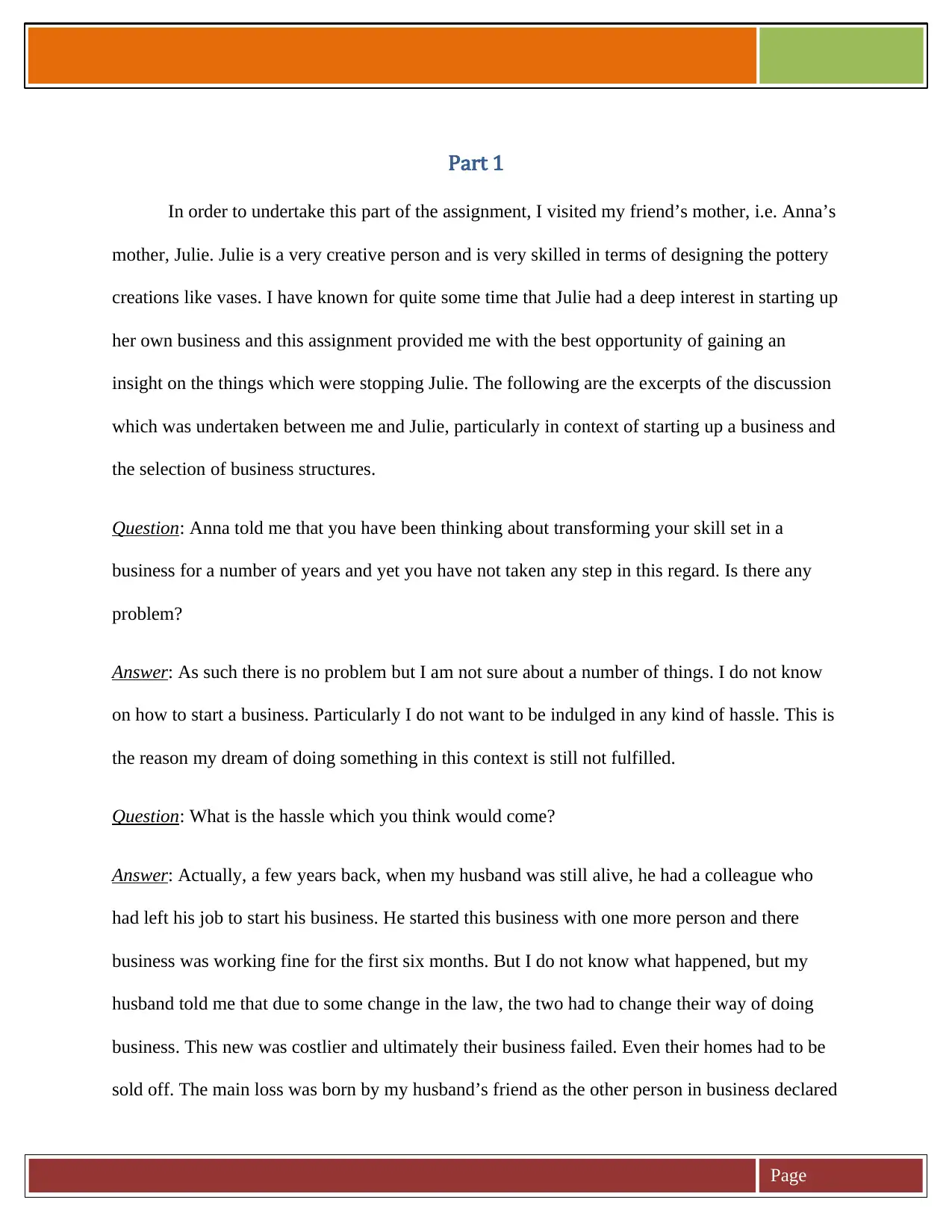
Page
Part 1
In order to undertake this part of the assignment, I visited my friend’s mother, i.e. Anna’s
mother, Julie. Julie is a very creative person and is very skilled in terms of designing the pottery
creations like vases. I have known for quite some time that Julie had a deep interest in starting up
her own business and this assignment provided me with the best opportunity of gaining an
insight on the things which were stopping Julie. The following are the excerpts of the discussion
which was undertaken between me and Julie, particularly in context of starting up a business and
the selection of business structures.
Question: Anna told me that you have been thinking about transforming your skill set in a
business for a number of years and yet you have not taken any step in this regard. Is there any
problem?
Answer: As such there is no problem but I am not sure about a number of things. I do not know
on how to start a business. Particularly I do not want to be indulged in any kind of hassle. This is
the reason my dream of doing something in this context is still not fulfilled.
Question: What is the hassle which you think would come?
Answer: Actually, a few years back, when my husband was still alive, he had a colleague who
had left his job to start his business. He started this business with one more person and there
business was working fine for the first six months. But I do not know what happened, but my
husband told me that due to some change in the law, the two had to change their way of doing
business. This new was costlier and ultimately their business failed. Even their homes had to be
sold off. The main loss was born by my husband’s friend as the other person in business declared
Part 1
In order to undertake this part of the assignment, I visited my friend’s mother, i.e. Anna’s
mother, Julie. Julie is a very creative person and is very skilled in terms of designing the pottery
creations like vases. I have known for quite some time that Julie had a deep interest in starting up
her own business and this assignment provided me with the best opportunity of gaining an
insight on the things which were stopping Julie. The following are the excerpts of the discussion
which was undertaken between me and Julie, particularly in context of starting up a business and
the selection of business structures.
Question: Anna told me that you have been thinking about transforming your skill set in a
business for a number of years and yet you have not taken any step in this regard. Is there any
problem?
Answer: As such there is no problem but I am not sure about a number of things. I do not know
on how to start a business. Particularly I do not want to be indulged in any kind of hassle. This is
the reason my dream of doing something in this context is still not fulfilled.
Question: What is the hassle which you think would come?
Answer: Actually, a few years back, when my husband was still alive, he had a colleague who
had left his job to start his business. He started this business with one more person and there
business was working fine for the first six months. But I do not know what happened, but my
husband told me that due to some change in the law, the two had to change their way of doing
business. This new was costlier and ultimately their business failed. Even their homes had to be
sold off. The main loss was born by my husband’s friend as the other person in business declared
⊘ This is a preview!⊘
Do you want full access?
Subscribe today to unlock all pages.

Trusted by 1+ million students worldwide
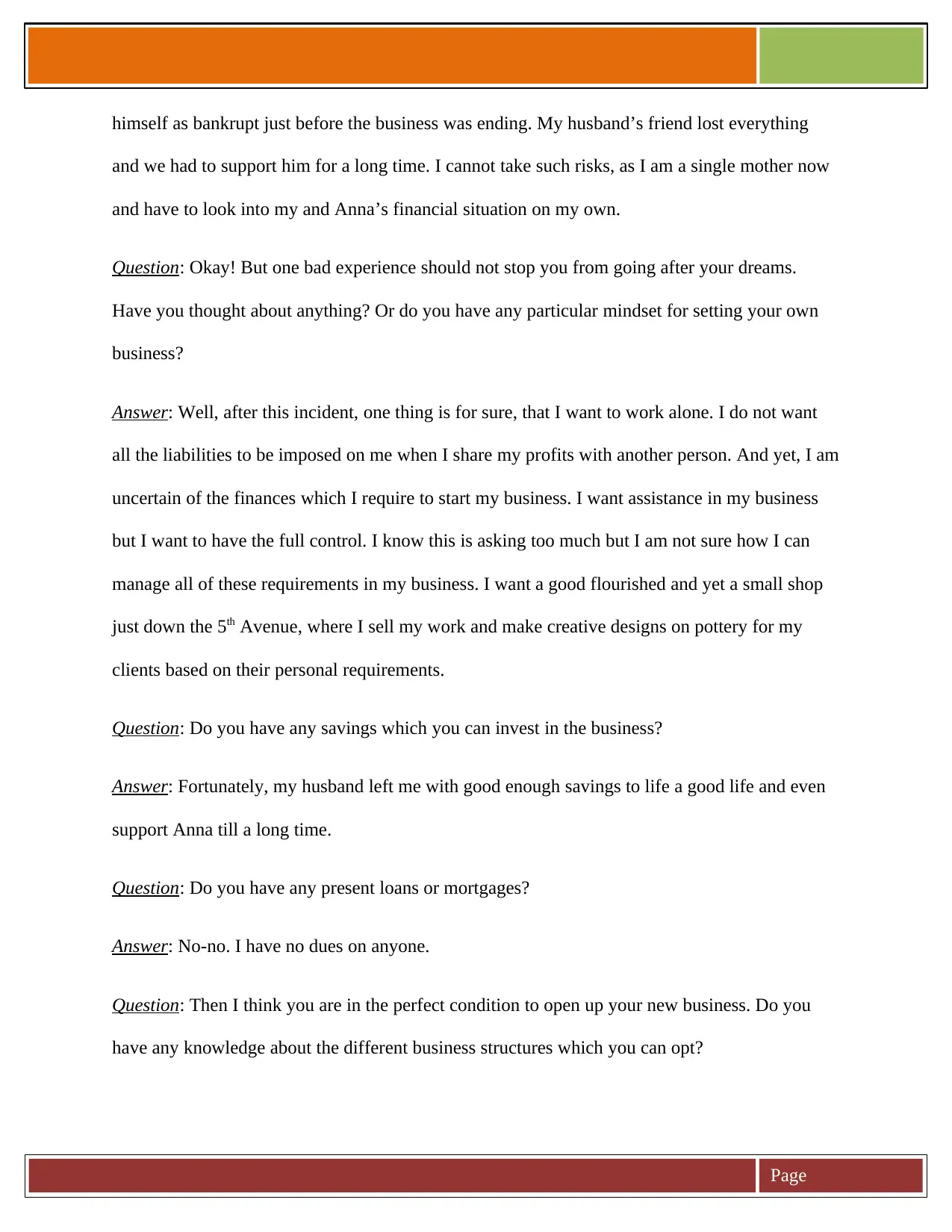
Page
himself as bankrupt just before the business was ending. My husband’s friend lost everything
and we had to support him for a long time. I cannot take such risks, as I am a single mother now
and have to look into my and Anna’s financial situation on my own.
Question: Okay! But one bad experience should not stop you from going after your dreams.
Have you thought about anything? Or do you have any particular mindset for setting your own
business?
Answer: Well, after this incident, one thing is for sure, that I want to work alone. I do not want
all the liabilities to be imposed on me when I share my profits with another person. And yet, I am
uncertain of the finances which I require to start my business. I want assistance in my business
but I want to have the full control. I know this is asking too much but I am not sure how I can
manage all of these requirements in my business. I want a good flourished and yet a small shop
just down the 5th Avenue, where I sell my work and make creative designs on pottery for my
clients based on their personal requirements.
Question: Do you have any savings which you can invest in the business?
Answer: Fortunately, my husband left me with good enough savings to life a good life and even
support Anna till a long time.
Question: Do you have any present loans or mortgages?
Answer: No-no. I have no dues on anyone.
Question: Then I think you are in the perfect condition to open up your new business. Do you
have any knowledge about the different business structures which you can opt?
himself as bankrupt just before the business was ending. My husband’s friend lost everything
and we had to support him for a long time. I cannot take such risks, as I am a single mother now
and have to look into my and Anna’s financial situation on my own.
Question: Okay! But one bad experience should not stop you from going after your dreams.
Have you thought about anything? Or do you have any particular mindset for setting your own
business?
Answer: Well, after this incident, one thing is for sure, that I want to work alone. I do not want
all the liabilities to be imposed on me when I share my profits with another person. And yet, I am
uncertain of the finances which I require to start my business. I want assistance in my business
but I want to have the full control. I know this is asking too much but I am not sure how I can
manage all of these requirements in my business. I want a good flourished and yet a small shop
just down the 5th Avenue, where I sell my work and make creative designs on pottery for my
clients based on their personal requirements.
Question: Do you have any savings which you can invest in the business?
Answer: Fortunately, my husband left me with good enough savings to life a good life and even
support Anna till a long time.
Question: Do you have any present loans or mortgages?
Answer: No-no. I have no dues on anyone.
Question: Then I think you are in the perfect condition to open up your new business. Do you
have any knowledge about the different business structures which you can opt?
Paraphrase This Document
Need a fresh take? Get an instant paraphrase of this document with our AI Paraphraser
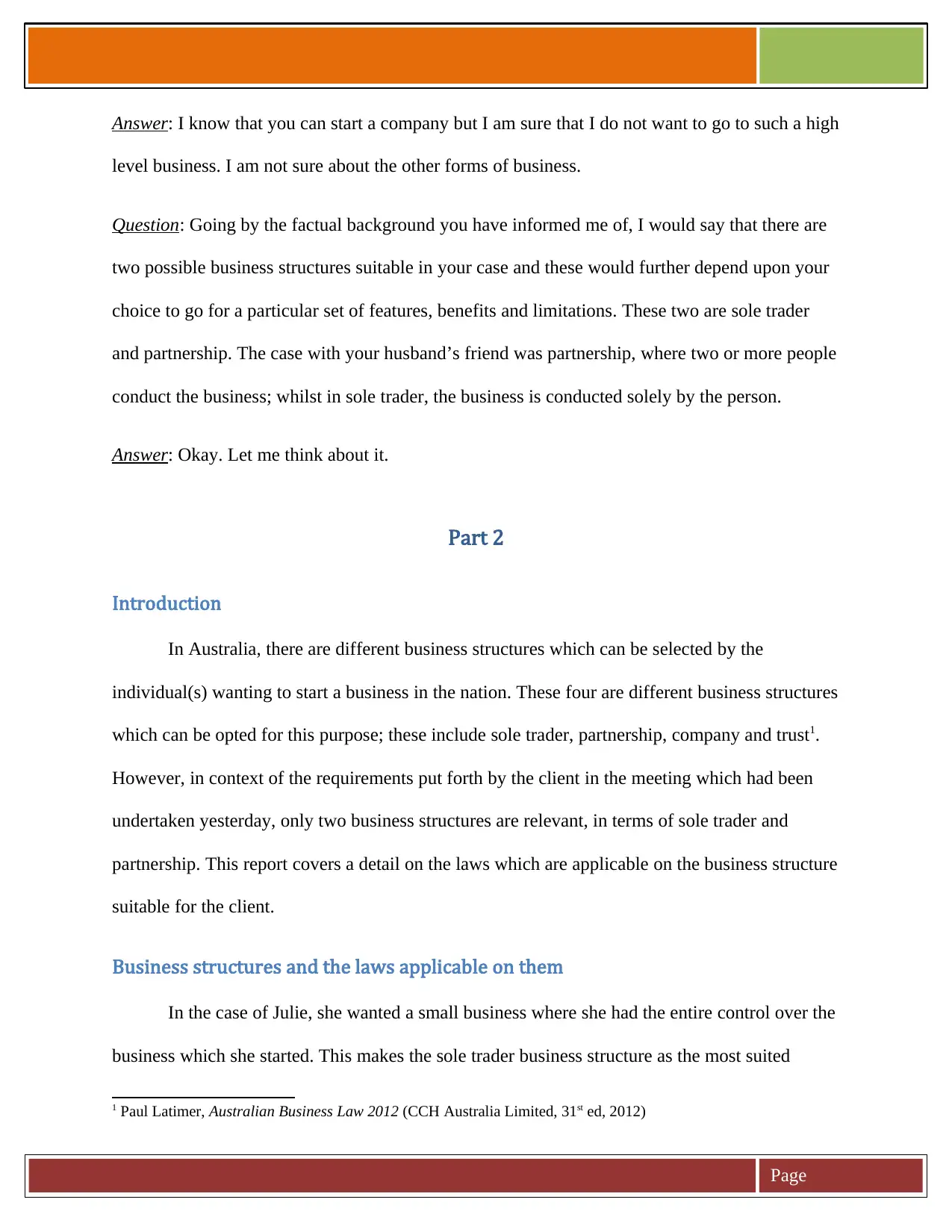
Page
Answer: I know that you can start a company but I am sure that I do not want to go to such a high
level business. I am not sure about the other forms of business.
Question: Going by the factual background you have informed me of, I would say that there are
two possible business structures suitable in your case and these would further depend upon your
choice to go for a particular set of features, benefits and limitations. These two are sole trader
and partnership. The case with your husband’s friend was partnership, where two or more people
conduct the business; whilst in sole trader, the business is conducted solely by the person.
Answer: Okay. Let me think about it.
Part 2
Introduction
In Australia, there are different business structures which can be selected by the
individual(s) wanting to start a business in the nation. These four are different business structures
which can be opted for this purpose; these include sole trader, partnership, company and trust1.
However, in context of the requirements put forth by the client in the meeting which had been
undertaken yesterday, only two business structures are relevant, in terms of sole trader and
partnership. This report covers a detail on the laws which are applicable on the business structure
suitable for the client.
Business structures and the laws applicable on them
In the case of Julie, she wanted a small business where she had the entire control over the
business which she started. This makes the sole trader business structure as the most suited
1 Paul Latimer, Australian Business Law 2012 (CCH Australia Limited, 31st ed, 2012)
Answer: I know that you can start a company but I am sure that I do not want to go to such a high
level business. I am not sure about the other forms of business.
Question: Going by the factual background you have informed me of, I would say that there are
two possible business structures suitable in your case and these would further depend upon your
choice to go for a particular set of features, benefits and limitations. These two are sole trader
and partnership. The case with your husband’s friend was partnership, where two or more people
conduct the business; whilst in sole trader, the business is conducted solely by the person.
Answer: Okay. Let me think about it.
Part 2
Introduction
In Australia, there are different business structures which can be selected by the
individual(s) wanting to start a business in the nation. These four are different business structures
which can be opted for this purpose; these include sole trader, partnership, company and trust1.
However, in context of the requirements put forth by the client in the meeting which had been
undertaken yesterday, only two business structures are relevant, in terms of sole trader and
partnership. This report covers a detail on the laws which are applicable on the business structure
suitable for the client.
Business structures and the laws applicable on them
In the case of Julie, she wanted a small business where she had the entire control over the
business which she started. This makes the sole trader business structure as the most suited
1 Paul Latimer, Australian Business Law 2012 (CCH Australia Limited, 31st ed, 2012)
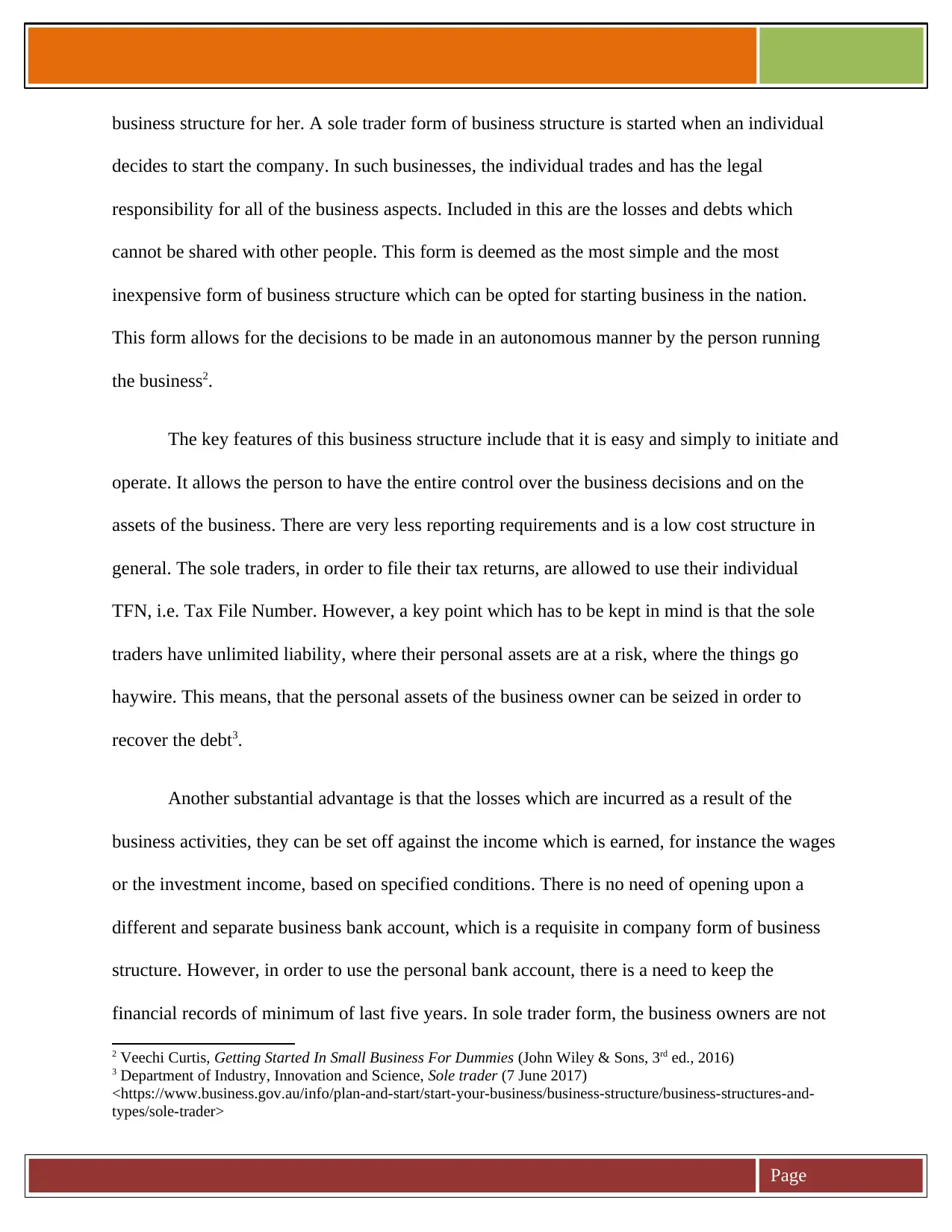
Page
business structure for her. A sole trader form of business structure is started when an individual
decides to start the company. In such businesses, the individual trades and has the legal
responsibility for all of the business aspects. Included in this are the losses and debts which
cannot be shared with other people. This form is deemed as the most simple and the most
inexpensive form of business structure which can be opted for starting business in the nation.
This form allows for the decisions to be made in an autonomous manner by the person running
the business2.
The key features of this business structure include that it is easy and simply to initiate and
operate. It allows the person to have the entire control over the business decisions and on the
assets of the business. There are very less reporting requirements and is a low cost structure in
general. The sole traders, in order to file their tax returns, are allowed to use their individual
TFN, i.e. Tax File Number. However, a key point which has to be kept in mind is that the sole
traders have unlimited liability, where their personal assets are at a risk, where the things go
haywire. This means, that the personal assets of the business owner can be seized in order to
recover the debt3.
Another substantial advantage is that the losses which are incurred as a result of the
business activities, they can be set off against the income which is earned, for instance the wages
or the investment income, based on specified conditions. There is no need of opening upon a
different and separate business bank account, which is a requisite in company form of business
structure. However, in order to use the personal bank account, there is a need to keep the
financial records of minimum of last five years. In sole trader form, the business owners are not
2 Veechi Curtis, Getting Started In Small Business For Dummies (John Wiley & Sons, 3rd ed., 2016)
3 Department of Industry, Innovation and Science, Sole trader (7 June 2017)
<https://www.business.gov.au/info/plan-and-start/start-your-business/business-structure/business-structures-and-
types/sole-trader>
business structure for her. A sole trader form of business structure is started when an individual
decides to start the company. In such businesses, the individual trades and has the legal
responsibility for all of the business aspects. Included in this are the losses and debts which
cannot be shared with other people. This form is deemed as the most simple and the most
inexpensive form of business structure which can be opted for starting business in the nation.
This form allows for the decisions to be made in an autonomous manner by the person running
the business2.
The key features of this business structure include that it is easy and simply to initiate and
operate. It allows the person to have the entire control over the business decisions and on the
assets of the business. There are very less reporting requirements and is a low cost structure in
general. The sole traders, in order to file their tax returns, are allowed to use their individual
TFN, i.e. Tax File Number. However, a key point which has to be kept in mind is that the sole
traders have unlimited liability, where their personal assets are at a risk, where the things go
haywire. This means, that the personal assets of the business owner can be seized in order to
recover the debt3.
Another substantial advantage is that the losses which are incurred as a result of the
business activities, they can be set off against the income which is earned, for instance the wages
or the investment income, based on specified conditions. There is no need of opening upon a
different and separate business bank account, which is a requisite in company form of business
structure. However, in order to use the personal bank account, there is a need to keep the
financial records of minimum of last five years. In sole trader form, the business owners are not
2 Veechi Curtis, Getting Started In Small Business For Dummies (John Wiley & Sons, 3rd ed., 2016)
3 Department of Industry, Innovation and Science, Sole trader (7 June 2017)
<https://www.business.gov.au/info/plan-and-start/start-your-business/business-structure/business-structures-and-
types/sole-trader>
⊘ This is a preview!⊘
Do you want full access?
Subscribe today to unlock all pages.

Trusted by 1+ million students worldwide
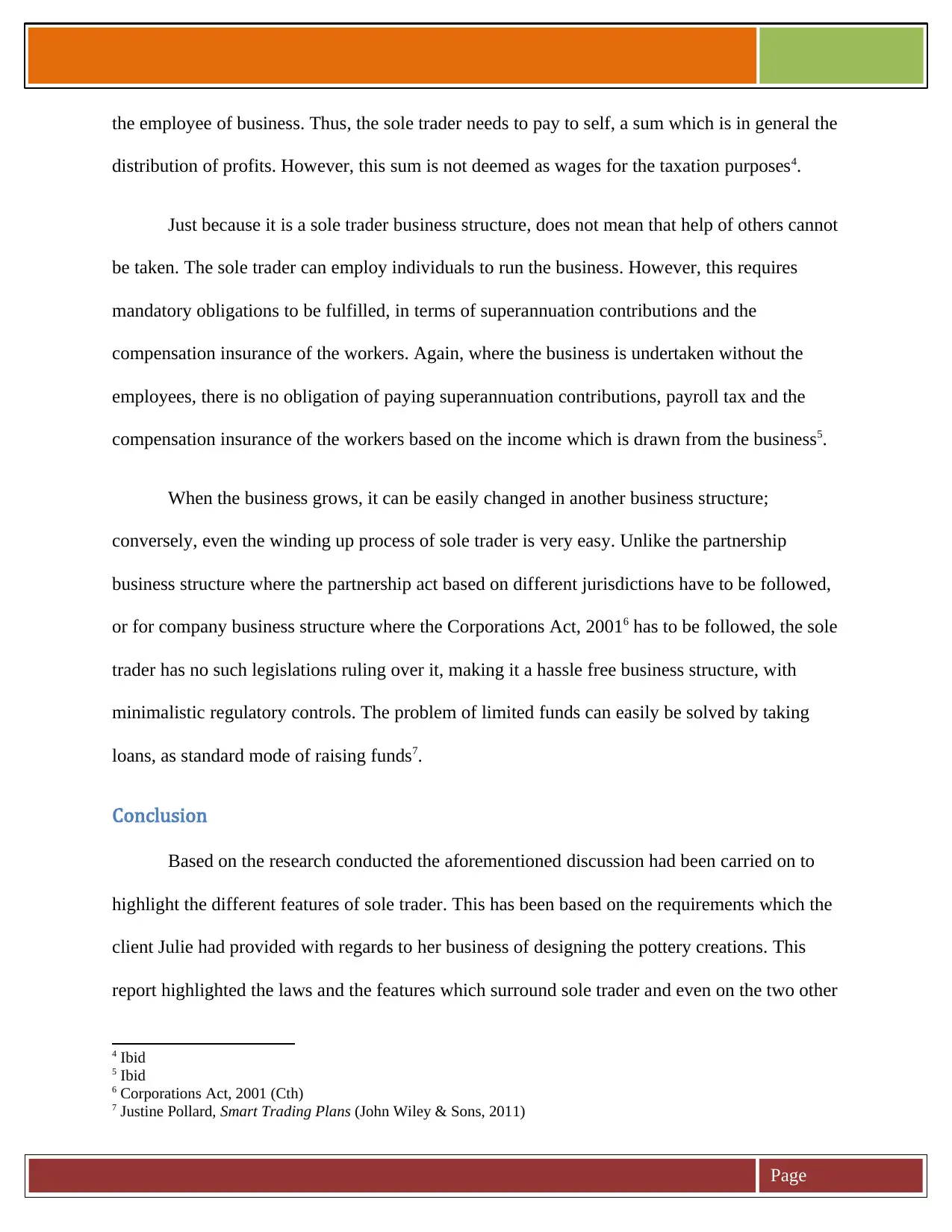
Page
the employee of business. Thus, the sole trader needs to pay to self, a sum which is in general the
distribution of profits. However, this sum is not deemed as wages for the taxation purposes4.
Just because it is a sole trader business structure, does not mean that help of others cannot
be taken. The sole trader can employ individuals to run the business. However, this requires
mandatory obligations to be fulfilled, in terms of superannuation contributions and the
compensation insurance of the workers. Again, where the business is undertaken without the
employees, there is no obligation of paying superannuation contributions, payroll tax and the
compensation insurance of the workers based on the income which is drawn from the business5.
When the business grows, it can be easily changed in another business structure;
conversely, even the winding up process of sole trader is very easy. Unlike the partnership
business structure where the partnership act based on different jurisdictions have to be followed,
or for company business structure where the Corporations Act, 20016 has to be followed, the sole
trader has no such legislations ruling over it, making it a hassle free business structure, with
minimalistic regulatory controls. The problem of limited funds can easily be solved by taking
loans, as standard mode of raising funds7.
Conclusion
Based on the research conducted the aforementioned discussion had been carried on to
highlight the different features of sole trader. This has been based on the requirements which the
client Julie had provided with regards to her business of designing the pottery creations. This
report highlighted the laws and the features which surround sole trader and even on the two other
4 Ibid
5 Ibid
6 Corporations Act, 2001 (Cth)
7 Justine Pollard, Smart Trading Plans (John Wiley & Sons, 2011)
the employee of business. Thus, the sole trader needs to pay to self, a sum which is in general the
distribution of profits. However, this sum is not deemed as wages for the taxation purposes4.
Just because it is a sole trader business structure, does not mean that help of others cannot
be taken. The sole trader can employ individuals to run the business. However, this requires
mandatory obligations to be fulfilled, in terms of superannuation contributions and the
compensation insurance of the workers. Again, where the business is undertaken without the
employees, there is no obligation of paying superannuation contributions, payroll tax and the
compensation insurance of the workers based on the income which is drawn from the business5.
When the business grows, it can be easily changed in another business structure;
conversely, even the winding up process of sole trader is very easy. Unlike the partnership
business structure where the partnership act based on different jurisdictions have to be followed,
or for company business structure where the Corporations Act, 20016 has to be followed, the sole
trader has no such legislations ruling over it, making it a hassle free business structure, with
minimalistic regulatory controls. The problem of limited funds can easily be solved by taking
loans, as standard mode of raising funds7.
Conclusion
Based on the research conducted the aforementioned discussion had been carried on to
highlight the different features of sole trader. This has been based on the requirements which the
client Julie had provided with regards to her business of designing the pottery creations. This
report highlighted the laws and the features which surround sole trader and even on the two other
4 Ibid
5 Ibid
6 Corporations Act, 2001 (Cth)
7 Justine Pollard, Smart Trading Plans (John Wiley & Sons, 2011)
Paraphrase This Document
Need a fresh take? Get an instant paraphrase of this document with our AI Paraphraser
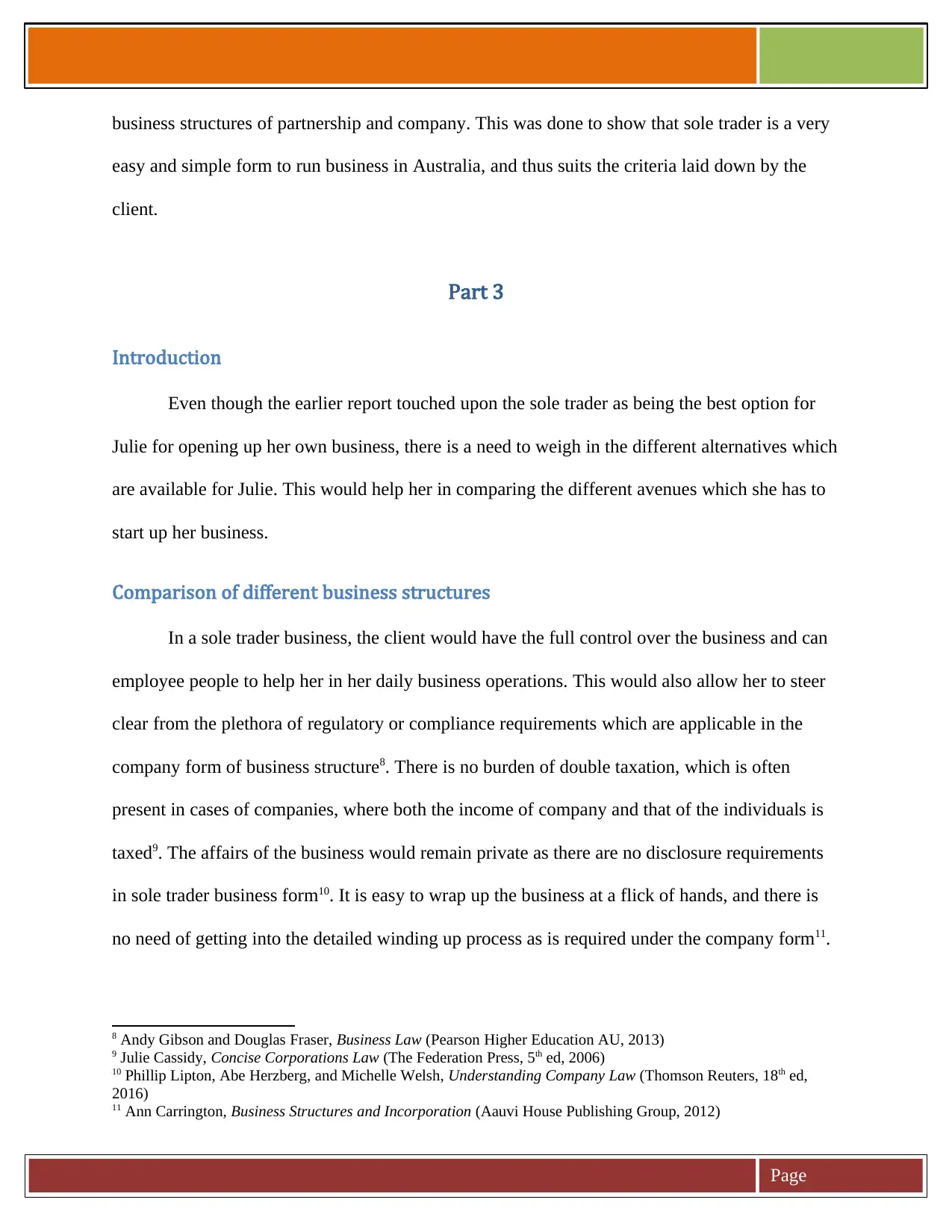
Page
business structures of partnership and company. This was done to show that sole trader is a very
easy and simple form to run business in Australia, and thus suits the criteria laid down by the
client.
Part 3
Introduction
Even though the earlier report touched upon the sole trader as being the best option for
Julie for opening up her own business, there is a need to weigh in the different alternatives which
are available for Julie. This would help her in comparing the different avenues which she has to
start up her business.
Comparison of different business structures
In a sole trader business, the client would have the full control over the business and can
employee people to help her in her daily business operations. This would also allow her to steer
clear from the plethora of regulatory or compliance requirements which are applicable in the
company form of business structure8. There is no burden of double taxation, which is often
present in cases of companies, where both the income of company and that of the individuals is
taxed9. The affairs of the business would remain private as there are no disclosure requirements
in sole trader business form10. It is easy to wrap up the business at a flick of hands, and there is
no need of getting into the detailed winding up process as is required under the company form11.
8 Andy Gibson and Douglas Fraser, Business Law (Pearson Higher Education AU, 2013)
9 Julie Cassidy, Concise Corporations Law (The Federation Press, 5th ed, 2006)
10 Phillip Lipton, Abe Herzberg, and Michelle Welsh, Understanding Company Law (Thomson Reuters, 18th ed,
2016)
11 Ann Carrington, Business Structures and Incorporation (Aauvi House Publishing Group, 2012)
business structures of partnership and company. This was done to show that sole trader is a very
easy and simple form to run business in Australia, and thus suits the criteria laid down by the
client.
Part 3
Introduction
Even though the earlier report touched upon the sole trader as being the best option for
Julie for opening up her own business, there is a need to weigh in the different alternatives which
are available for Julie. This would help her in comparing the different avenues which she has to
start up her business.
Comparison of different business structures
In a sole trader business, the client would have the full control over the business and can
employee people to help her in her daily business operations. This would also allow her to steer
clear from the plethora of regulatory or compliance requirements which are applicable in the
company form of business structure8. There is no burden of double taxation, which is often
present in cases of companies, where both the income of company and that of the individuals is
taxed9. The affairs of the business would remain private as there are no disclosure requirements
in sole trader business form10. It is easy to wrap up the business at a flick of hands, and there is
no need of getting into the detailed winding up process as is required under the company form11.
8 Andy Gibson and Douglas Fraser, Business Law (Pearson Higher Education AU, 2013)
9 Julie Cassidy, Concise Corporations Law (The Federation Press, 5th ed, 2006)
10 Phillip Lipton, Abe Herzberg, and Michelle Welsh, Understanding Company Law (Thomson Reuters, 18th ed,
2016)
11 Ann Carrington, Business Structures and Incorporation (Aauvi House Publishing Group, 2012)
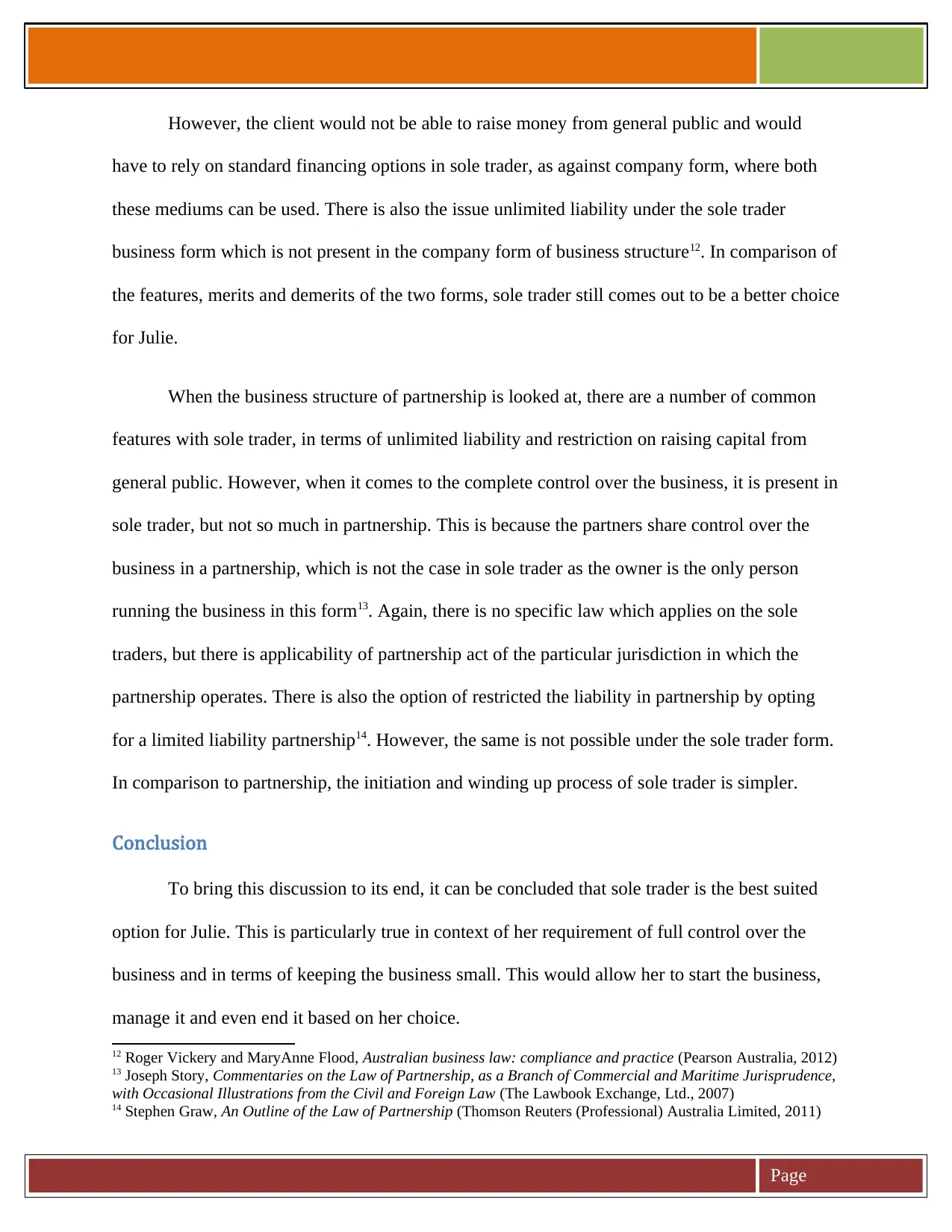
Page
However, the client would not be able to raise money from general public and would
have to rely on standard financing options in sole trader, as against company form, where both
these mediums can be used. There is also the issue unlimited liability under the sole trader
business form which is not present in the company form of business structure12. In comparison of
the features, merits and demerits of the two forms, sole trader still comes out to be a better choice
for Julie.
When the business structure of partnership is looked at, there are a number of common
features with sole trader, in terms of unlimited liability and restriction on raising capital from
general public. However, when it comes to the complete control over the business, it is present in
sole trader, but not so much in partnership. This is because the partners share control over the
business in a partnership, which is not the case in sole trader as the owner is the only person
running the business in this form13. Again, there is no specific law which applies on the sole
traders, but there is applicability of partnership act of the particular jurisdiction in which the
partnership operates. There is also the option of restricted the liability in partnership by opting
for a limited liability partnership14. However, the same is not possible under the sole trader form.
In comparison to partnership, the initiation and winding up process of sole trader is simpler.
Conclusion
To bring this discussion to its end, it can be concluded that sole trader is the best suited
option for Julie. This is particularly true in context of her requirement of full control over the
business and in terms of keeping the business small. This would allow her to start the business,
manage it and even end it based on her choice.
12 Roger Vickery and MaryAnne Flood, Australian business law: compliance and practice (Pearson Australia, 2012)
13 Joseph Story, Commentaries on the Law of Partnership, as a Branch of Commercial and Maritime Jurisprudence,
with Occasional Illustrations from the Civil and Foreign Law (The Lawbook Exchange, Ltd., 2007)
14 Stephen Graw, An Outline of the Law of Partnership (Thomson Reuters (Professional) Australia Limited, 2011)
However, the client would not be able to raise money from general public and would
have to rely on standard financing options in sole trader, as against company form, where both
these mediums can be used. There is also the issue unlimited liability under the sole trader
business form which is not present in the company form of business structure12. In comparison of
the features, merits and demerits of the two forms, sole trader still comes out to be a better choice
for Julie.
When the business structure of partnership is looked at, there are a number of common
features with sole trader, in terms of unlimited liability and restriction on raising capital from
general public. However, when it comes to the complete control over the business, it is present in
sole trader, but not so much in partnership. This is because the partners share control over the
business in a partnership, which is not the case in sole trader as the owner is the only person
running the business in this form13. Again, there is no specific law which applies on the sole
traders, but there is applicability of partnership act of the particular jurisdiction in which the
partnership operates. There is also the option of restricted the liability in partnership by opting
for a limited liability partnership14. However, the same is not possible under the sole trader form.
In comparison to partnership, the initiation and winding up process of sole trader is simpler.
Conclusion
To bring this discussion to its end, it can be concluded that sole trader is the best suited
option for Julie. This is particularly true in context of her requirement of full control over the
business and in terms of keeping the business small. This would allow her to start the business,
manage it and even end it based on her choice.
12 Roger Vickery and MaryAnne Flood, Australian business law: compliance and practice (Pearson Australia, 2012)
13 Joseph Story, Commentaries on the Law of Partnership, as a Branch of Commercial and Maritime Jurisprudence,
with Occasional Illustrations from the Civil and Foreign Law (The Lawbook Exchange, Ltd., 2007)
14 Stephen Graw, An Outline of the Law of Partnership (Thomson Reuters (Professional) Australia Limited, 2011)
⊘ This is a preview!⊘
Do you want full access?
Subscribe today to unlock all pages.

Trusted by 1+ million students worldwide
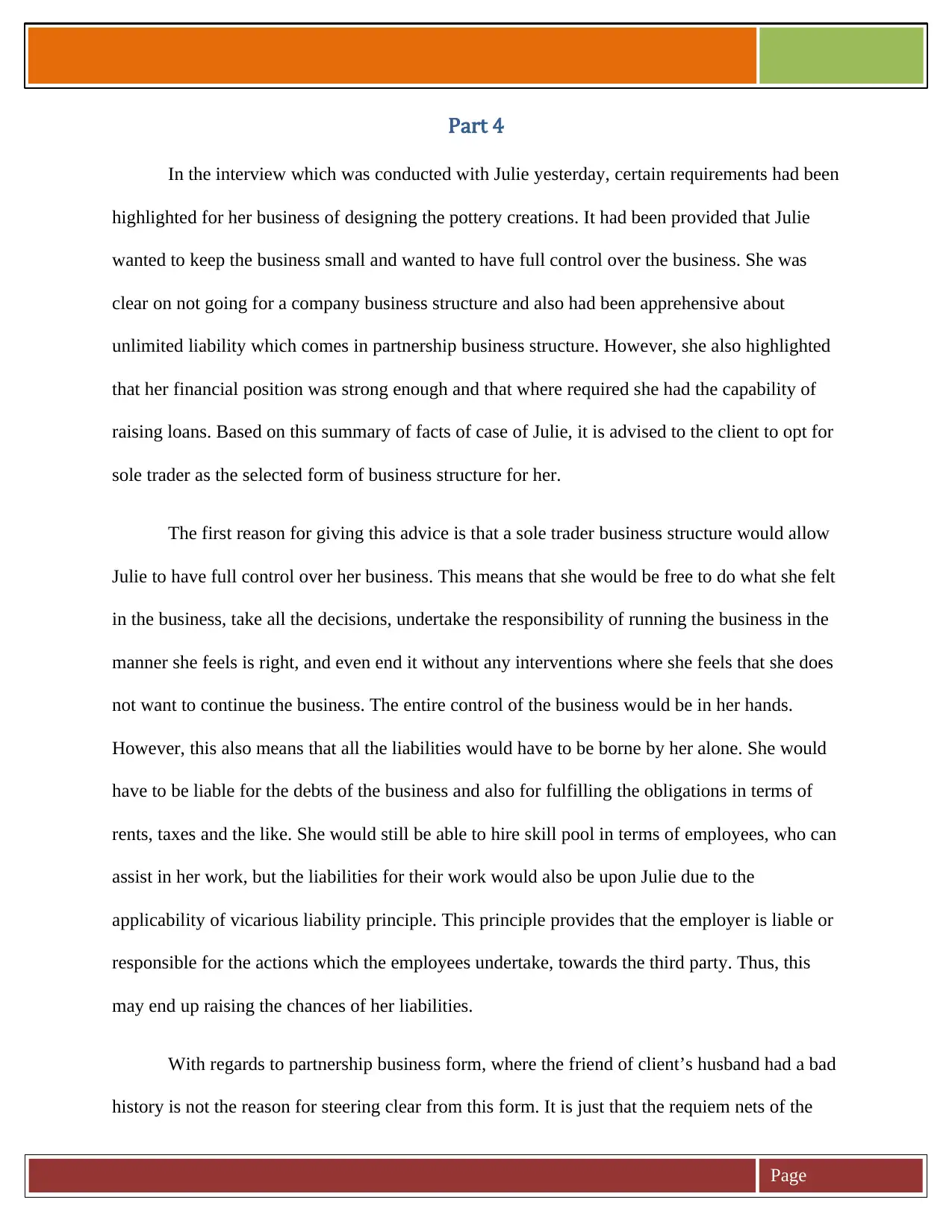
Page
Part 4
In the interview which was conducted with Julie yesterday, certain requirements had been
highlighted for her business of designing the pottery creations. It had been provided that Julie
wanted to keep the business small and wanted to have full control over the business. She was
clear on not going for a company business structure and also had been apprehensive about
unlimited liability which comes in partnership business structure. However, she also highlighted
that her financial position was strong enough and that where required she had the capability of
raising loans. Based on this summary of facts of case of Julie, it is advised to the client to opt for
sole trader as the selected form of business structure for her.
The first reason for giving this advice is that a sole trader business structure would allow
Julie to have full control over her business. This means that she would be free to do what she felt
in the business, take all the decisions, undertake the responsibility of running the business in the
manner she feels is right, and even end it without any interventions where she feels that she does
not want to continue the business. The entire control of the business would be in her hands.
However, this also means that all the liabilities would have to be borne by her alone. She would
have to be liable for the debts of the business and also for fulfilling the obligations in terms of
rents, taxes and the like. She would still be able to hire skill pool in terms of employees, who can
assist in her work, but the liabilities for their work would also be upon Julie due to the
applicability of vicarious liability principle. This principle provides that the employer is liable or
responsible for the actions which the employees undertake, towards the third party. Thus, this
may end up raising the chances of her liabilities.
With regards to partnership business form, where the friend of client’s husband had a bad
history is not the reason for steering clear from this form. It is just that the requiem nets of the
Part 4
In the interview which was conducted with Julie yesterday, certain requirements had been
highlighted for her business of designing the pottery creations. It had been provided that Julie
wanted to keep the business small and wanted to have full control over the business. She was
clear on not going for a company business structure and also had been apprehensive about
unlimited liability which comes in partnership business structure. However, she also highlighted
that her financial position was strong enough and that where required she had the capability of
raising loans. Based on this summary of facts of case of Julie, it is advised to the client to opt for
sole trader as the selected form of business structure for her.
The first reason for giving this advice is that a sole trader business structure would allow
Julie to have full control over her business. This means that she would be free to do what she felt
in the business, take all the decisions, undertake the responsibility of running the business in the
manner she feels is right, and even end it without any interventions where she feels that she does
not want to continue the business. The entire control of the business would be in her hands.
However, this also means that all the liabilities would have to be borne by her alone. She would
have to be liable for the debts of the business and also for fulfilling the obligations in terms of
rents, taxes and the like. She would still be able to hire skill pool in terms of employees, who can
assist in her work, but the liabilities for their work would also be upon Julie due to the
applicability of vicarious liability principle. This principle provides that the employer is liable or
responsible for the actions which the employees undertake, towards the third party. Thus, this
may end up raising the chances of her liabilities.
With regards to partnership business form, where the friend of client’s husband had a bad
history is not the reason for steering clear from this form. It is just that the requiem nets of the
Paraphrase This Document
Need a fresh take? Get an instant paraphrase of this document with our AI Paraphraser
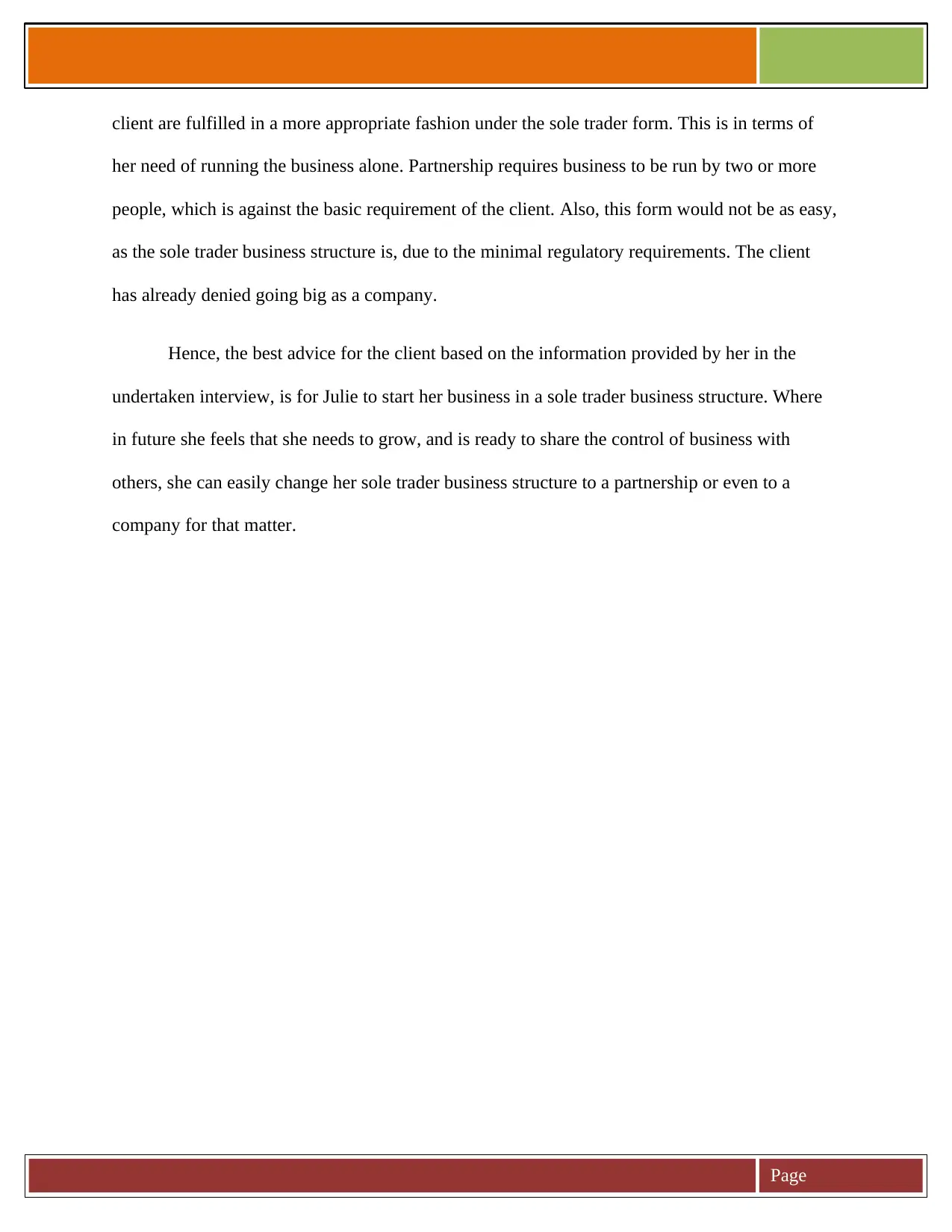
Page
client are fulfilled in a more appropriate fashion under the sole trader form. This is in terms of
her need of running the business alone. Partnership requires business to be run by two or more
people, which is against the basic requirement of the client. Also, this form would not be as easy,
as the sole trader business structure is, due to the minimal regulatory requirements. The client
has already denied going big as a company.
Hence, the best advice for the client based on the information provided by her in the
undertaken interview, is for Julie to start her business in a sole trader business structure. Where
in future she feels that she needs to grow, and is ready to share the control of business with
others, she can easily change her sole trader business structure to a partnership or even to a
company for that matter.
client are fulfilled in a more appropriate fashion under the sole trader form. This is in terms of
her need of running the business alone. Partnership requires business to be run by two or more
people, which is against the basic requirement of the client. Also, this form would not be as easy,
as the sole trader business structure is, due to the minimal regulatory requirements. The client
has already denied going big as a company.
Hence, the best advice for the client based on the information provided by her in the
undertaken interview, is for Julie to start her business in a sole trader business structure. Where
in future she feels that she needs to grow, and is ready to share the control of business with
others, she can easily change her sole trader business structure to a partnership or even to a
company for that matter.
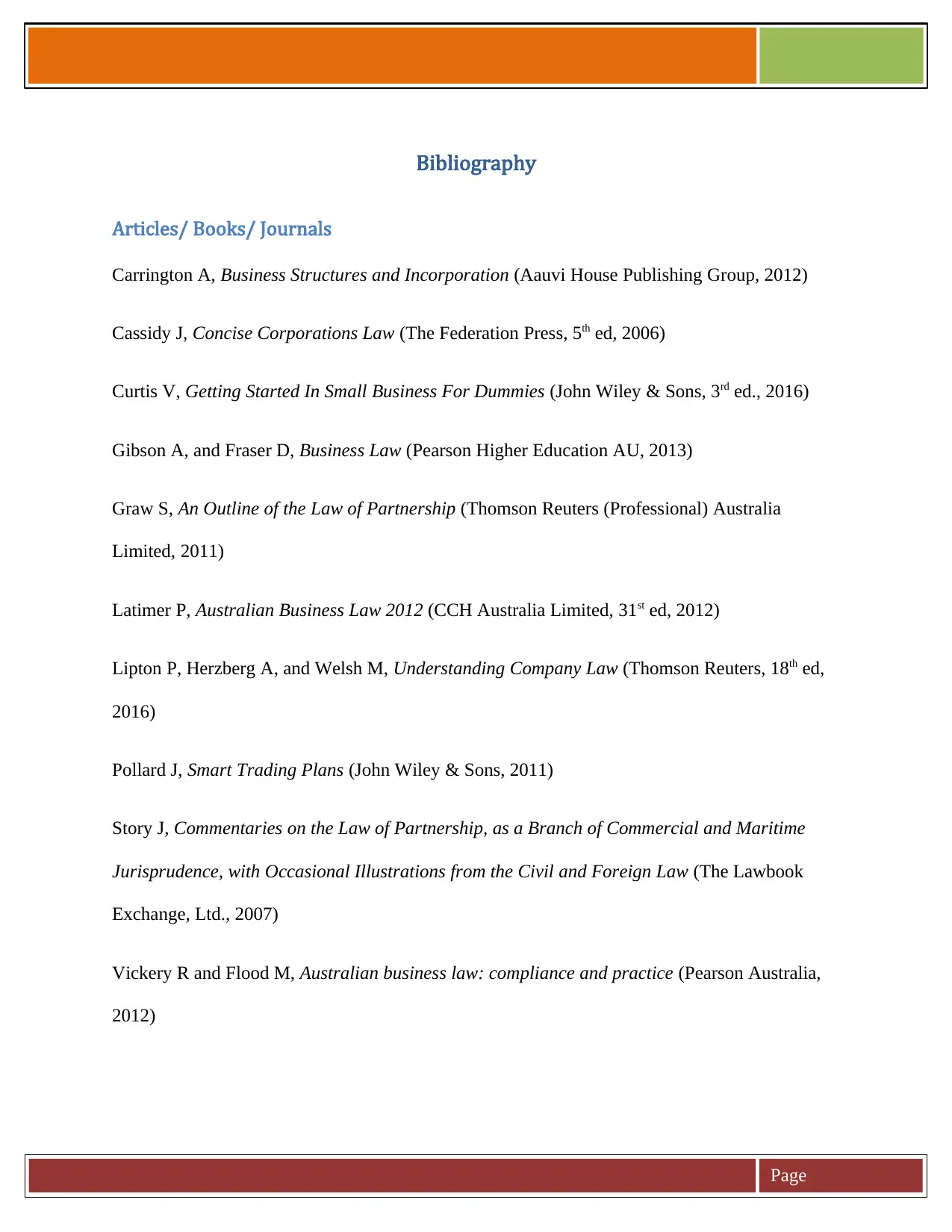
Page
Bibliography
Articles/ Books/ Journals
Carrington A, Business Structures and Incorporation (Aauvi House Publishing Group, 2012)
Cassidy J, Concise Corporations Law (The Federation Press, 5th ed, 2006)
Curtis V, Getting Started In Small Business For Dummies (John Wiley & Sons, 3rd ed., 2016)
Gibson A, and Fraser D, Business Law (Pearson Higher Education AU, 2013)
Graw S, An Outline of the Law of Partnership (Thomson Reuters (Professional) Australia
Limited, 2011)
Latimer P, Australian Business Law 2012 (CCH Australia Limited, 31st ed, 2012)
Lipton P, Herzberg A, and Welsh M, Understanding Company Law (Thomson Reuters, 18th ed,
2016)
Pollard J, Smart Trading Plans (John Wiley & Sons, 2011)
Story J, Commentaries on the Law of Partnership, as a Branch of Commercial and Maritime
Jurisprudence, with Occasional Illustrations from the Civil and Foreign Law (The Lawbook
Exchange, Ltd., 2007)
Vickery R and Flood M, Australian business law: compliance and practice (Pearson Australia,
2012)
Bibliography
Articles/ Books/ Journals
Carrington A, Business Structures and Incorporation (Aauvi House Publishing Group, 2012)
Cassidy J, Concise Corporations Law (The Federation Press, 5th ed, 2006)
Curtis V, Getting Started In Small Business For Dummies (John Wiley & Sons, 3rd ed., 2016)
Gibson A, and Fraser D, Business Law (Pearson Higher Education AU, 2013)
Graw S, An Outline of the Law of Partnership (Thomson Reuters (Professional) Australia
Limited, 2011)
Latimer P, Australian Business Law 2012 (CCH Australia Limited, 31st ed, 2012)
Lipton P, Herzberg A, and Welsh M, Understanding Company Law (Thomson Reuters, 18th ed,
2016)
Pollard J, Smart Trading Plans (John Wiley & Sons, 2011)
Story J, Commentaries on the Law of Partnership, as a Branch of Commercial and Maritime
Jurisprudence, with Occasional Illustrations from the Civil and Foreign Law (The Lawbook
Exchange, Ltd., 2007)
Vickery R and Flood M, Australian business law: compliance and practice (Pearson Australia,
2012)
⊘ This is a preview!⊘
Do you want full access?
Subscribe today to unlock all pages.

Trusted by 1+ million students worldwide
1 out of 13
Related Documents
Your All-in-One AI-Powered Toolkit for Academic Success.
+13062052269
info@desklib.com
Available 24*7 on WhatsApp / Email
![[object Object]](/_next/static/media/star-bottom.7253800d.svg)
Unlock your academic potential
Copyright © 2020–2025 A2Z Services. All Rights Reserved. Developed and managed by ZUCOL.





